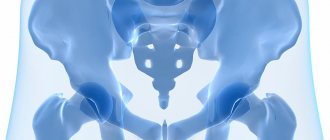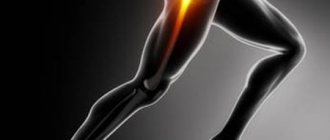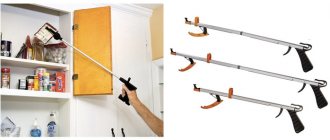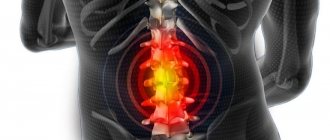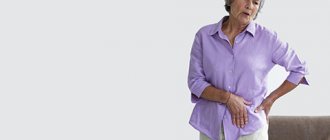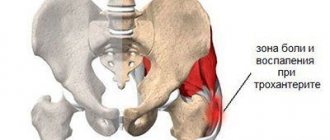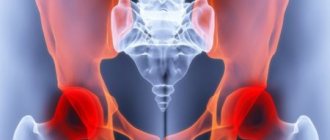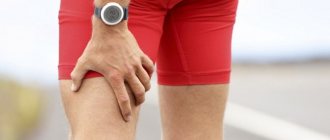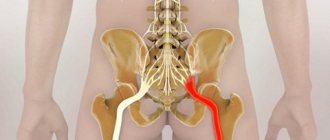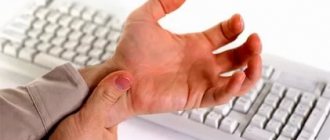The truth about the hip joint. Life without pain
How it all started
I was 22 years old when I suffered a series of serious injuries in a car accident while serving in the army. There were so many injuries, and my condition after this accident was so severe that the doctors simply did not attach any importance to the complete dislocation of the femoral head (which was immediately reduced) and, without subsequent traction of the hip, began to save my life. I was in a coma for 12 days (my death was officially announced. My colleagues even managed to drink to the repose of God’s servant...). I am grateful to them for saving my life. But when I got out of there and began to look at the world meaningfully, the doctors forgot about the realigned hip joint, as they were busy reconstructing the remains of my leg. Three operations were performed. Life, thank God, was saved, and then live yourself as you want, crutches in your hands - and full speed ahead. Of course, no one talked to me about the possible complications of this very “complete dislocation of the femoral head,” and I had no idea about such a threatening disease for the joint as coxarthrosis.
After returning home as a group II disabled person, I began to behave absolutely incorrectly in relation to my own health, or rather, the musculoskeletal system. And even now, when I remember what I did with my body while disabled, I get chills!
There were so many injuries, and my condition after this accident was so severe that the doctors simply did not attach any importance to the complete dislocation of the femoral head (which was immediately reduced) and, without subsequent traction of the hip, began to save my life.
What was I doing? I worked out with weights and bodybuilding. There were no exercise machines then, so weights, dumbbells, and a barbell were the approximate arsenal of my home-grown rehabilitation. Played basketball! To football! I even did karate! Why did I do this? I wanted to live! There were no rehabilitation specialists. And even now there are few of them. The system does not prepare such people. Now I can already offer modern kinesitherapy. A method that I was able to develop thanks to these injuries. Then, not understanding the physiology of pain, I felt good during these very games, because the working muscles relieved inflammation. But since I did not remove the load from the joint and spine (the last three vertebrae and intervertebral discs were crushed, and the vertebrae were fused with deformed bodies), but on the contrary, I increased them many times, then after classes, 20–30 minutes later, I could not do either step without pain.
When I tried to move, sweat flowed down my back and body so profusely that my mother asked if I had been caught in the rain. I felt sorry for my parents and didn’t tell them about the pain. They already got it from me. They were “buried” twice. Before the army, I had another unpleasant traumatic episode, also with clinical death. So here it is. In the subway, I knew all the points on the platform in front of which the doors of the trains opened. Only in this case did I have the opportunity to be the first to enter the carriage and take a seat.
I counted the steps, the meters that had to be overcome on the way. After these, if I may say so, “rehabilitation exercises.”
I removed crutches from my arsenal (also in vain) and used a cane. And I was constantly looking for different ways to train my body. There was no money, but I had friends - coaches with whom I once studied at the Faculty of Physical Education, graduated from it after the army on crutches. Friends provided me with free time in their swimming pools and gyms and supported me in every possible way during those years. I wanted to live! I loved life after I got out of there! But I didn't know how to live! Pain, pain and pain! From morning to evening. Sometimes I drank to relax, but it didn’t bring me joy.
And then he caught the eye of one of his friends. My stories about pain were unpleasant to him. I generally can't stand it when people feel sorry for me. But, as they say, drunkenness loosened my tongue, and I complained, although I didn’t ask for help. But this look from my friend... maybe even contemptuous... And I thought... What will happen next if, at the age of 26, I began to cry into my vest?
And then somehow, after another game of basketball, leaving the gym, I realized that I couldn’t walk... at all. There's no one around. I sat down on the edge of the sidewalk and... no, I didn’t cry! But I was on the verge! Drink yourself or get out? Like Hamlet, but on crutches. I wanted to live, and to live normally! And the doctors forbade everything, even having children.
I had to understand my illness, but this requires knowledge! And I decided to go to medical school. But what if they don’t hire people with disabilities?
This was my question and I solved it! There was only one higher education, and I used it. I managed to get certificates that allowed me, a disabled person, to study from my attending physicians. Along the way, I had another operation on the hip joint (then I learned about coxarthrosis) for free, it was in the Soviet Union. Now there are also such opportunities, but it is very difficult to wait in line! And the quality of such treatment... Although with the correct tactics of preparing a patient for surgery, you can achieve positive results, even if the operation was performed from material that is not of the highest quality.
As a rule, they do not think about this, otherwise they would be sent before any planned operation (and not only with diseases of the musculoskeletal system) to the Kinesitherapy Center for preoperative preparation. This would make it possible to recover faster and better in the same Kinesitherapy Center, but after surgery. My more than 30 years of practice allows me to state this quite categorically.
But the patients themselves are not always ready to undergo preoperative preparation. No matter how much you explain to them, a person is lazy, and I am convinced of this every day! The media has hammered into people's heads the miracle of operations and only advertises surgeons. But any operation, even the most beautiful one, needs serious, professional follow-up treatment, as it creates many other problems that did not exist before the operation (sutures, muscle atrophy, etc.). And my story is a vivid illustration of this. Only a threat to life is grounds for immediate surgery on any organ or joint.
Having entered the medical faculty of the 3rd Moscow Medical Institute, I began to gain knowledge. It was not easy to study, my head was broken, although I was interested in everything, maybe except for physics and chemistry in the first year.
Having become a medical student, I did not stop looking for everything alternative that would help me personally get out of a situation that was incomprehensible to me. At that time, the abbreviation healthy lifestyle was poorly understood by most, and those who were fond of a healthy lifestyle were called black sheep. Now it has become fashionable. Studying at a medical institute[3] allowed me to undergo consultations with leading doctors in Moscow, but they only smiled skeptically when I asked how to help me. Doctors have this unpleasant habit of smiling cynically if they do not know the answer to a question asked by a patient. Or they make jokes, like, how can a patient understand something?
By the end of the 2nd year, I realized: official medicine does not study the rules and laws of health. She studies diseases and how medications can be manipulated to keep people living an unhealthy lifestyle.
Therefore, with even greater persistence I studied everything alternative that was not permitted by medicine.
I continued to accumulate my achievements. I studied everything that was available at that time in such literature[4]: from fasting to urine therapy, from yoga to the Amosov system, etc. Some helped, some not so much. Met a lot of interesting people working in alternative medicine. Unfortunately, there were practically no professional doctors among them. This prevented us from achieving the desired result. But overall, I became stronger and began to understand what happened to me. Removed aggressive influences and, naturally, turned off axial loads on the joints and spine.
Official medicine studies diseases and methods of manipulating medications to maintain the life of a person leading an unhealthy lifestyle.
Using the developed system, I lost 36 kg in three months (since then I have been indifferent to diets) and began to literally fly. That is, the crutch no longer interfered with life. I, a 3rd year student at the Faculty of Medicine, developed certain techniques and began to study - yes, yes! - private practice. I went to the villages of Russia, the villages of Uzbekistan, to see my friends. Yes, I also had patients in Moscow. He worked in three places, received a pension, a stipend and something from medical practice (at the same time he did not insist on paying for his consultations). Mainly, naturally, I worked with the spine and joints.
I was approached as the last hope by people thrown overboard by big medicine. As a rule, if they trusted me completely, their hopes were fulfilled! Since then, it has been like this: people come to me in extremely serious condition. This requires a lot! You have to take full responsibility upon yourself. But this is what the patient needs - to trust his doctor! The main thing is that the doctor justifies this belief!
I remember this period of my life in such detail because I am sure that many, after reading my medical history, will think about it and begin their own path - the path to deliverance. And stories like these helped me at one time. But at that time, officially I was something of an outcast. After all, there was no such profession. After college, when during perestroika doctors were allowed to work as they saw fit, I finally received freedom of action.
At the same time, having already created a full-fledged system of modern kinesitherapy, for a long time I did not want to believe that I would not do without surgery on the joint. And the statistics of outcomes after endoprosthetics confused me. There are too many marriages! Now I know what's going on!
Let's return, however, to George Cooker, 69 years old, weight 135 kg, bilateral hip damage. However, despite all this, he is a cheerful joker.
I started working with him in October, knowing that he would have his first endoprosthetics surgery (there would be two in total) in February. George turned out to be an obedient patient. I performed all the suggested exercises on the simulators conscientiously. In general, I must say that foreigners (I have quite a lot of experience working with them) are very disciplined people, unlike our Russian patients. Ours will come to the doctor with a disease that the previous doctor could not cope with, and during the consultation he will refer to the opinion of the one who did not help him. Or, even more, on the opinion of the neighbor on the landing. Russian paradox! Everyone knows about their illnesses, they just get sick all the time.
In working with George, our main emphasis was on the hip extensor muscles, which we all sit on, so in most people they are poorly developed, and the muscles of the lumbar region. Let me remind you that the basic concept of modern kinesitherapy: in most chronic diseases of the musculoskeletal system (musculoskeletal system), muscular insufficiency of the body, or even atrophy of individual muscle groups, is to blame.
Everything was going well. Time worked for George, and we worked with him for about 1.5 months. He told me that the doctor at the Boston hospital had moved the operation to early December. Well, George, go ahead!
He arrived a month after the operation. I examined it, tested it on simulators and was delighted with the result. I have never encountered anything like this in such cases! No muscle contractures, no restrictions in the mobility of the operated leg (which is observed in almost all patients who did not prepare the leg for surgery). The leg strength is quite decent. And I, who had been resisting the same operation on myself for almost 27 years, said: “George, I agree!”
And George replied: “Come with me to Boston in the summer. I will have surgery on my second joint, and you on yours!” That's what they decided on.
All that remains is to collect money, agree on a time frame, get a visa and, together with George, go to the surgeon.
Time has passed!
I will tell you this story day by day - the story of my final recovery. For 27 years I resisted, fought with coxarthrosis. This was a professional, not an amateur fight. But I still had to decide to have the operation. For many years I have been studying this disease, and at the same time other lesions of the musculoskeletal system (I prefer the correct phrase: “musculoskeletal system”).
The result was the creation of a new direction in medical practice - modern kinesitherapy, which destroyed all the established stereotypes of rehabilitation therapy. True, so far in narrow local areas of Russia and neighboring countries, in centers working according to this method, official medicine stands like a rock.
Modern kinesitherapy has allowed everything that was previously prohibited during rehabilitation, and does not recommend using what was allowed by the same conservative medicine. Now a new name has appeared: exercise therapy - restorative medicine. But nothing fundamentally has changed in this direction. The laws of non-surgical treatment of many diseases of the spine and joints (herniated intervertebral discs, glenohumeral periarthritis in the “frozen shoulder” stage) have also been discovered in kinesitherapy. But this has not yet interested conservative doctors. Unless until you solve your own health problems in the field of musculoskeletal disorders.
* * *
“That’s enough,” I told myself, “it’s time to give up.”
Annex 1
Abstracts of S.M. Bubnovsky’s speech. at the IV Russian National Congress “Man and His Health” 2009 (for specialists)
1. Kinesitherapy – treatment of tissue dystrophies in order to restore metabolism and structural organization of connective tissue by methods of recruiting skeletal muscles through the use of narrow-local and multifunctional decompression strength training equipment.
2. The proposed method of modern kinesitherapy uses the phenomenon of intraorgan function of skeletal muscles, that is, the movement of blood and lymph. It is enhanced many times over due to its pumping activation (recruitment).
3. A set of nerve centers controls skeletal muscles with the help of nerve impulses by dosing the contraction force necessary to perform a specific motor task.
4. Failure to use skeletal muscles in the early stages of recovery after total endoprosthetics leads not only to a decrease in muscle mass, but also to a sharp decrease in the vascular network, topographically located in the muscle tissue space. This increases the risk of developing osteoparetic phenomena not only in the partially resected limb, but also in the surrounding anatomical areas (pelvic bones, lumbar spine), since osteoarthrosis is accompanied by osteochondrosis of the spine.
5. The problem of early and high-quality activation in the postoperative regime was solved using the methods of modern kinesitherapy using modern biomechanical simulators of narrow-local and multifunctional action, which have imperative geometry of movements and fine differentiation of physical influences in order to enhance the pumping function of muscle tissue.
6. It must be remembered that each large joint of the lower limb is surrounded by large muscle groups: flexors-extensors, adductors-abductors, which perform not only a corset-motor function, but also, thanks to abundant vascularization, a trophic one.
7. Between the extra-articular ligaments of the hip joint there are three weak (thinned) areas of the joint capsule. The first (anterior) weak point of the capsule is located between the iliofemoral and pubofemoral ligaments, and is strengthened by exercises - see photo 4 a, b. The second (posterior) - between the iliofemoral and ischiofemoral ligaments, is strengthened by exercises - see photo 3 a, b. The third (lower) - between the pubofemoral and ischiofemoral ligaments, is strengthened by exercises - see photo 11 a, b. In these places, the head of the femur may come out when it is dislocated. Thus, the largest and most powerful joint of the body has its own Achilles zones, the prevention of which falls entirely on strength training equipment in the practice of kinesitherapy. Weak legs are future complications after endoprosthetics.
8. The overwhelming number of treatment methods exclude the dominant role of muscle tissue in limb remodeling. In this regard, NSAIDs actively used in the postoperative regime and various types of restrictions on physical activity (sometimes up to 6 months) worsen the possibility of regeneration and trophism of connective tissue.
9. Postoperative patients, due to these prohibitions, quickly get used to restrictions in everyday life, try to avoid any physical activity, and seek help in everyday life. This is how a certain and extremely stable type of behavior is formed, which is based on fear of pain and helplessness.
10. Physical efforts are programmed strictly according to individual capabilities, and from session to session the main load is gradually transferred from the training device to the working muscle group.
11. In addition to applying actual muscular effort, the patient learns diaphragmatic breathing, which reduces intra-abdominal and intrathoracic pressure. This also dramatically reduces the load on the cardiovascular system and allows for rehabilitation of patients with HIHD, COPD (chronic coronary heart disease, chronic obstructive pulmonary disease) and other diseases.
12. Thanks to an active position in the rehabilitation process, the patient has the opportunity to refuse additional support in a short time - from 4 to 6 weeks, while getting rid of fear and helplessness.
13. It should be noted that the practice of kinesitherapy recommends that patients undergoing total joint replacement undergo preoperative preparation, including for grade III–IV osteoarthritis, in order to quickly activate the postoperative regimen.
14. The complexity of simulator rehabilitation lies in the need for an individual approach when drawing up a treatment program, taking into account the individual characteristics of each patient (gender, weight, age) and the presence of concomitant diseases. It is this approach that can eliminate possible complications that arise, as practice shows, when performing unprogrammed movements with uncontrolled tension of the muscles of the lower extremity belt (bending, rotation, hyperextension) of a patient detrained by the disease.
15. It must be remembered that an operating doctor who directs his patient to modern training rehabilitation in the postoperative period, and even more so prescribes it in the preoperative period, will always feel gratitude from the patient. Only through the interaction of specialists throughout the treatment process can the level of complications after total joint replacement be reduced. There is such a possibility.
